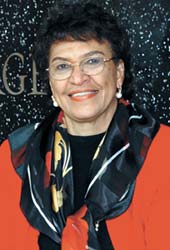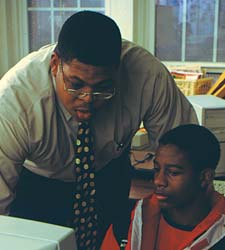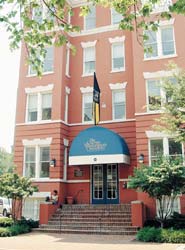|
|

The Teachers’ College class of 1911, as shown in this Cherry Tree yearbook photograph.
|
By Laura Ewald

The Graduate School of Education and Human Development commemorates its 100th birthday this year with a special convocation and reception, and an archival exhibit in the Gelman Library. These events honor the school’s steady growth and contributions to the University.
GW first offered teacher preparation courses through the Columbian College of Arts and Sciences in 1904. The Division of Education was established in 1907, which became the Teachers College in 1909, and was then renamed the School of Education in 1929. In the 1970s, the school’s focus shifted to graduate education, and in 1994, it took on its current name. Today, GSEHD houses three departments, offers 20 master’s degree programs and six doctoral degree programs, and has grown to include more than 70 full-time faculty and 1,600 students.
|

GSEHD Dean and Professor of Educational Policy Studies Mary Futrell is a former president of the National Education Association. In 2003, she received the NEA Foundation Award for Outstanding Service to Public Education.
Photo Claire Duggan
|
Through its many incarnations, the school has helped other departments and schools evolve as well. As the first home to programs such as travel and tourism, physical education, and dance, GSEHD helped them find places in the school of management, athletics department, and Columbian College, respectively.
Naturally, GSEHD also has made an impact on the lives of its alumni. After World War II, the school helped a number of retired military officers—already skilled in areas such as math and science—to complete their education and find teaching and administration jobs. Today, the school continues to meet the changing needs of its students and the community through several special programs.
GSEHD’s Urban Initiative Partnership offers a professional development experience at D.C.’s Cardozo High School for candidates seeking to teach secondary education and secondary special education. The master’s degree program, offered to about nine graduate students a year, leads to a dual certification.
Also benefiting local interests is the Capital Educators Collaborative. Established by GSEHD, it is the District’s local chapter of the Holmes Partnership, a national consortium of universities and school system partnerships that supports reform initiatives and encourages teachers seeking certification.
Another program through a grant from the Potomac Tech-nology Empowerment Center makes technology more accessible and useful to area schools by supporting and expanding the D.C. Area Community Technology Centers.
|

As an intern at D.C.’s Francis L. Cardozo High School in 1999, Turnell Sims, MA ’99, MEd ’99, spent one-on-one time with students, participated in teacher planning and troubleshooting meetings, and went on field trips as a part of GSEHD’s Urban Initiative.
Photo Rick Reinhard
|
And GSEHD’s Institute for Education Policy Studies develops practices to reduce violence in schools and communities, researches and reforms curriculum standards, and prepares educators to provide best practices to linguistically and culturally diverse student populations.
These and other initiatives have garnered national attention. GSEHD received more than $21 million in sponsored research grants and contracts in 2003, ranking fifth in the nation in research dollars per faculty member and ninth in the nation in total funded research. U.S. News and World Report’s annual guide to graduate schools ranks GSEHD 24th out of 189 U.S. graduate schools of education. The school ranked third in the United States among private National Council for Accreditation of Teacher Education-accredited schools.
Professor Emeritus John Boswell, BA ’53, MA ’56, EdD ’63, says the school’s successes are due in large part to a committed faculty.
“We have faculty members who care about what they are doing and what they teach,” Boswell says. “These are people who know about their field and know how to help their students.”
GSEHD’s small class sizes allow faculty members to give students personal attention, which Boswell cites as another of the school’s strengths.
And with national policy being created blocks away from campus, Boswell says GSEHD faculty and students have always been able to keep an eye on and influence the legislation that affects education.
|

2134 G Street has been GSEHD’s home since 1995.
Photo Claire Duggan
|
“Being in D.C. makes a difference. We can keep up to date with what is going on and have also been able to bring influential people into our classrooms,” Boswell says. “We have found that many people in Washington are giving of their time, and that has been invaluable to our students.”
The school’s centennial celebrations are already underway. In October 2003, GSEHD’s annual New Directions Conference kicked off the festivities with faculty lunches and commemorative medallions.
GSEHD Dean and Professor of Educational Policy Studies Mary Futrell has enjoyed celebrating with her school’s community. “Our faculty, staff, students, and alumni are proud of the history of the school and its accomplishments,” Futrell says. “I have had several alumni come up to me at different events to tell me how grateful they are for their education and how much it has helped them succeed.”
Futrell also looks forward to events still to come. She expects about 300 students and alumni to attend a special convocation and reception this coming October.
“There’s a general feel of excitement in the air for our school,” she says. “We look forward to not only honoring our history, but looking ahead to our next 100 years.”
Back to top | Spring 2004 Table of Contents
|